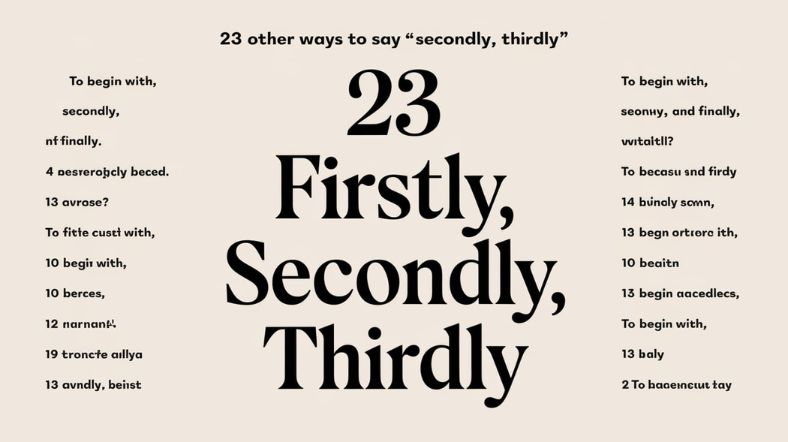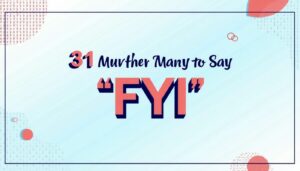In any writing, it is important to vary the way we introduce different points in order to make our arguments or thoughts more engaging and dynamic.
The commonly used terms “Firstly,” “Secondly,” and “Thirdly” often sound repetitive and can be improved with other alternatives.
In this article, we’ll explore 26 different ways to replace these terms, making your communication more polished and effective.
Firstly, Secondly, Thirdly Alternatives
Instead of relying on “Firstly,” “Secondly,” and “Thirdly,” which can become monotonous, try these alternatives to introduce your points. These alternatives are suitable for formal essays, casual conversations, presentations, or professional reports.
Firstly, Secondly, Thirdly, Fourthly, Fifthly, Sixthly, Seventhly, Eighthly, Ninthly, Tenthly
It’s easy to fall into the habit of using the same phrases repeatedly, but there are many alternatives to choose from. Here’s a list for extending your sequence in an organized and more engaging way:
- Fourthly: “In the fourth place”
- Fifthly: “The fifth point is”
- Sixthly: “Next, we have”
- Seventhly: “The seventh consideration is”
- Eighthly: “To add on, eighthly”
- Ninthly: “The ninth point to note is”
- Tenthly: “Finally, in tenth place”
Using these alternatives keeps your writing organized while also making it more engaging.
Firstly, Secondly, Thirdly in Essay
In academic essays, the use of transitions is key to presenting a logical flow of ideas. While “Firstly,” “Secondly,” and “Thirdly” are standard, here are some alternatives to consider:
- To begin: Common in introductory sections where you start presenting your arguments.
- One point to consider is: This variation adds emphasis on the importance of the point.
- Additionally: Helps when adding another argument or reason.
- In the same way: Shows continuity in presenting ideas.
By using these alternatives, your essay will feel more cohesive and engaging for the reader.
What Kind of Connectives Are These: Firstly, Secondly, Thirdly?
The phrases “Firstly,” “Secondly,” and “Thirdly” are all examples of ordinal connectives. These connectives are used to organize points in a sequence, which helps in maintaining clarity and logical progression. However, they can sometimes sound repetitive, and that’s why it’s good to use alternatives. Other examples of connectives include:
- Firstly, Secondly, Thirdly: Used for listing reasons or points.
- Moreover: Adds on to a previous statement or argument.
- Consequently: Introduces the result or outcome of a point made earlier.
Firstly, Secondly, Thirdly Examples
Here are examples using “Firstly,” “Secondly,” and “Thirdly” to show how they function in a sentence:
- Firstly: “Firstly, we need to determine our goals for the year.”
- Secondly: “Secondly, we should evaluate the resources available for the project.”
- Thirdly: “Thirdly, the team will have to coordinate effectively for timely execution.”
These transitions help structure your argument, but alternatives can offer a more interesting approach.
Firstly, Secondly, Thirdly Lastly
“Lastly” is commonly used to signal the final point in a discussion. Here’s an example of how you might structure a list:
- Firstly: “Firstly, we should review all available data.”
- Secondly: “Secondly, it is important to consult with stakeholders.”
- Thirdly: “Thirdly, we need to finalize the budget.”
- Lastly: “Lastly, we will implement the plan and track progress.”
Using “Lastly” emphasizes that your argument is coming to a conclusion.
Another Word for Thirdly
If “Thirdly” sounds repetitive in your writing, here are some alternatives:
- Third: Simple and direct.
- The third point is: A formal alternative.
- In third place: Often used in rankings or comparisons.
- Another consideration is: Suitable for informal and formal writing.
Connectives
Connectives are essential tools in both spoken and written language that help to organize thoughts, show relationships, and make communication clearer. Connectives such as “Firstly,” “Secondly,” and “Thirdly” are often used to establish sequence. Some alternatives include:
- For example
- In addition
- Consequently
- On the other hand
Using these connectives adds variety to your speech or writing and improves the overall flow of your communication.
Firstly Secondly Thirdly Sentences
Here are examples of sentences that use the common sequence terms, “Firstly,” “Secondly,” and “Thirdly”:
- Firstly, the team should focus on developing the project scope.
- Secondly, we need to establish a timeline for each phase.
- Thirdly, we must allocate the necessary resources to meet deadlines.
These phrases are often used in academic or professional contexts where clarity is important.
Firstly Secondly Thirdly Exercises
If you’re working on a writing exercise, try replacing “Firstly,” “Secondly,” and “Thirdly” with some of the alternatives we’ve discussed. This can help you develop a more versatile and dynamic writing style.
Exercise Example:
- Instructions: Rewrite the paragraph using at least three different alternatives to “Firstly,” “Secondly,” and “Thirdly.”
First Synonym for Essay
A synonym for “essay” could be:
- Paper: Often used in academic settings.
- Article: More commonly used for journals, magazines, or blogs.
- Dissertation: A long essay, typically used for academic research.
Different synonyms can be used depending on the length and type of writing you’re referring to.
Another Word for Second in an Essay
Instead of using “Secondly” in your essay, try these alternatives:
- The second point: Simple and effective.
- Secondly, we can consider: A more descriptive approach.
- In the second place: Slightly formal, useful in structured writing.
Another Word for Thirdly in an Essay
For replacing “Thirdly” in essays, you can use:
- Third: The simplest alternative.
- The third argument is: Offers a more formal tone.
- Next, we should consider: Keeps the flow going and avoids repetition.
To Begin
This is a great way to start a list or present an idea, especially in formal writing.
Example:
“To begin, let’s review the financial forecasts for the coming quarter.”
To Start With
Commonly used in less formal or casual writing, this phrase introduces the first point.
Example:
“To start with, I’ll highlight the major challenges we face.”
First
As mentioned earlier, “First” is a direct and simple alternative to “Firstly.” It can be used in both formal and casual settings.
Example:
“First, let’s examine the current market trends.”
One Reason Is
This is a useful alternative to introduce the first reason or argument. It’s helpful in persuasive writing.
Example:
“One reason is that the new approach will streamline our processes.”
Following From That
This phrase can transition smoothly from one point to another, showing that the next point builds upon the previous one.
Example:
“Following from that, we need to implement new software to enhance efficiency.”
After That
“After that” is an informal alternative that helps guide the reader or listener through the sequence of points.
Example:
“After that, we can begin implementing the changes.”
Second
The simple “Second” works just like “First,” clearly indicating the next point.
Example:
“Second, we need to determine the budget for the project.”
The Next Reason Is
This phrase introduces the second point, emphasizing that it’s building on what was previously discussed.
Example:
“The next reason is that customer satisfaction will improve as a result.”
Finally
“Finally” is a great choice when introducing your concluding point.
Example:
“Finally, we should conduct a review of the project to ensure everything is on track.”
Lastly
“Lastly” is another excellent transition that introduces the final point of discussion.
Example:
“Lastly, we need to discuss the next steps in the project.”
Conclusion
By using these alternatives to “Firstly,” “Secondly,” and “Thirdly,” you can significantly improve the flow and style of your writing.
Experiment with these phrases to find the ones that best suit your purpose and tone.
Whether for formal essays, casual conversations, or professional presentations, these transitions will add variety and structure to your communication.

Mark Tony is a grammar expert with 5 years of experience, specializing in teaching English grammar, enhancing writing, reading, and speaking skills for diverse learners.









